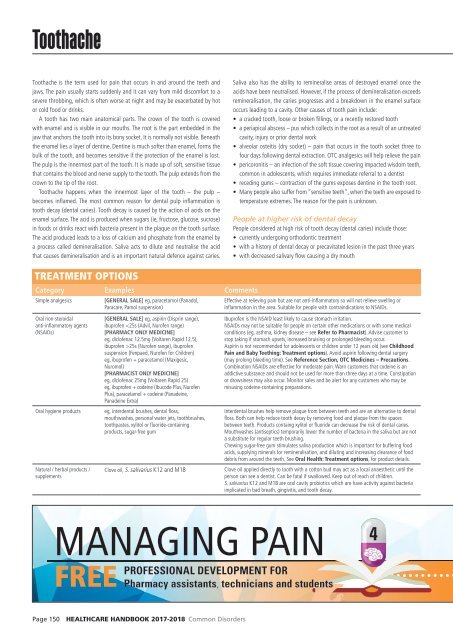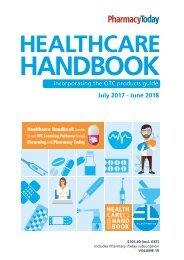2017 HCHB_digital
Create successful ePaper yourself
Turn your PDF publications into a flip-book with our unique Google optimized e-Paper software.
Toothache<br />
Toothache is the term used for pain that occurs in and around the teeth and<br />
jaws. The pain usually starts suddenly and it can vary from mild discomfort to a<br />
severe throbbing, which is often worse at night and may be exacerbated by hot<br />
or cold food or drinks.<br />
A tooth has two main anatomical parts. The crown of the tooth is covered<br />
with enamel and is visible in our mouths. The root is the part embedded in the<br />
jaw that anchors the tooth into its bony socket. It is normally not visible. Beneath<br />
the enamel lies a layer of dentine. Dentine is much softer than enamel, forms the<br />
bulk of the tooth, and becomes sensitive if the protection of the enamel is lost.<br />
The pulp is the innermost part of the tooth. It is made up of soft, sensitive tissue<br />
that contains the blood and nerve supply to the tooth. The pulp extends from the<br />
crown to the tip of the root.<br />
Toothache happens when the innermost layer of the tooth – the pulp –<br />
becomes inflamed. The most common reason for dental pulp inflammation is<br />
tooth decay (dental caries). Tooth decay is caused by the action of acids on the<br />
enamel surface. The acid is produced when sugars (ie, fructose, glucose, sucrose)<br />
in foods or drinks react with bacteria present in the plaque on the tooth surface.<br />
The acid produced leads to a loss of calcium and phosphate from the enamel by<br />
a process called demineralisation. Saliva acts to dilute and neutralise the acid<br />
that causes demineralisation and is an important natural defence against caries.<br />
Saliva also has the ability to remineralise areas of destroyed enamel once the<br />
acids have been neutralised. However, if the process of demineralisation exceeds<br />
remineralisation, the caries progresses and a breakdown in the enamel surface<br />
occurs leading to a cavity. Other causes of tooth pain include:<br />
• a cracked tooth, loose or broken fillings, or a recently restored tooth<br />
• a periapical abscess – pus which collects in the root as a result of an untreated<br />
cavity, injury or prior dental work<br />
• alveolar osteitis (dry socket) – pain that occurs in the tooth socket three to<br />
four days following dental extraction. OTC analgesics will help relieve the pain<br />
• pericoronitis – an infection of the soft tissue covering impacted wisdom teeth,<br />
common in adolescents, which requires immediate referral to a dentist<br />
• receding gums – contraction of the gums exposes dentine in the tooth root.<br />
• Many people also suffer from “sensitive teeth”, when the teeth are exposed to<br />
temperature extremes. The reason for the pain is unknown.<br />
People at higher risk of dental decay<br />
People considered at high risk of tooth decay (dental caries) include those:<br />
• currently undergoing orthodontic treatment<br />
• with a history of dental decay or precavitated lesion in the past three years<br />
• with decreased salivary flow causing a dry mouth<br />
TREATMENT OPTIONS<br />
Category Examples Comments<br />
Simple analgesics<br />
[GENERAL SALE] eg, paracetamol (Panadol,<br />
Paracare, Pamol suspension)<br />
Effective at relieving pain but are not anti-inflammatory so will not relieve swelling or<br />
inflammation in the area. Suitable for people with contraindications to NSAIDs.<br />
Oral non-steroidal<br />
anti-inflammatory agents<br />
(NSAIDs)<br />
Oral hygiene products<br />
Natural / herbal products /<br />
supplements<br />
[GENERAL SALE] eg, aspirin (Disprin range),<br />
ibuprofen 25s (Nurofen range), ibuprofen<br />
suspension (Fenpaed, Nurofen for Children)<br />
eg, ibuprofen + paracetamol (Maxigesic,<br />
Nuromol)<br />
[PHARMACIST ONLY MEDICINE]<br />
eg, diclofenac 25mg (Voltaren Rapid 25)<br />
eg, ibuprofen + codeine (Ibucode Plus, Nurofen<br />
Plus), paracetamol + codeine (Panadeine,<br />
Panadeine Extra)<br />
eg, interdental brushes, dental floss,<br />
mouthwashes, personal water jets, toothbrushes,<br />
toothpastes, xylitol or fluoride-containing<br />
products, sugar-free gum<br />
Clove oil, S. salivarius K12 and M18<br />
Ibuprofen is the NSAID least likely to cause stomach irritation.<br />
NSAIDs may not be suitable for people on certain other medications or with some medical<br />
conditions (eg, asthma, kidney disease – see Refer to Pharmacist). Advise customer to<br />
stop taking if stomach upsets, increased bruising or prolonged bleeding occur.<br />
Aspirin is not recommended for adolescents or children under 12 years old (see Childhood<br />
Pain and Baby Teething: Treatment options). Avoid aspirin following dental surgery<br />
(may prolong bleeding time). See Reference Section, OTC Medicines – Precautions.<br />
Combination NSAIDs are effective for moderate pain. Warn customers that codeine is an<br />
addictive substance and should not be used for more than three days at a time. Constipation<br />
or drowsiness may also occur. Monitor sales and be alert for any customers who may be<br />
misusing codeine-containing preparations.<br />
Interdental brushes help remove plaque from between teeth and are an alternative to dental<br />
floss. Both can help reduce tooth decay by removing food and plaque from the spaces<br />
between teeth. Products containg xylitol or fluoride can decrease the risk of dental caries.<br />
Mouthwashes (antiseptics) temporarily lower the number of bacteria in the saliva but are not<br />
a substitute for regular teeth brushing.<br />
Chewing sugar-free gum stimulates saliva production which is important for buffering food<br />
acids, supplying minerals for remineralisation, and diluting and increasing clearance of food<br />
debris from around the teeth. See Oral Health: Treatment options, for product details.<br />
Clove oil applied directly to tooth with a cotton bud may act as a local anaesthetic until the<br />
person can see a dentist. Can be fatal if swallowed. Keep out of reach of children.<br />
S. salivarius K12 and M18 are oral cavity probiotics which are have activity against bacteria<br />
implicated in bad breath, gingivitis, and tooth decay.<br />
MANAGING PAIN<br />
FREE<br />
PROFESSIONAL DEVELOPMENT FOR<br />
Pharmacy assistants, technicians and students<br />
4<br />
Page 150 HEALTHCARE HANDBOOK <strong>2017</strong>-2018 Common Disorders



